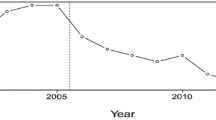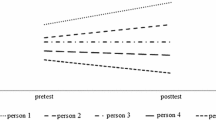Abstract
A model for the measurement of the discrepancy between two scores is presented and discussed as a paradigm for the study of growth or experimentally produced change. The model assumes two tests or measures differing in complexity, and it analyzes the true difference between the test scores into a component that is entirely dependent on the first or base-line test and a second component that is entirely independent of it. Equations for estimating both components are given and these are compared with other measurement efforts with similar goals.
Similar content being viewed by others
References
Berkson, J. Are there two regressions?J. Amer. statist. Ass., 1950,45, 164–180.
DuBois, P. H.Multivariate correlational analysis. New York: Harper, 1957.
Gulliksen, H.Theory of mental tests. New York: Wiley, 1950.
Harris, C. W. Some problems in the description of change.Educ. psychol. Measmt, 1962,22, 303–319.
Harris, C. W. (Ed.)Problems in measuring change. Madison: Univ. Wisconsin Press, 1963.
Lacey, J. I. The evaluation of autonomic responses: Toward a general solution.Ann. New York Acad. Sci., 1956,67, 123–164.
Lacey, J. I. and Lacey, B. C. The law of initial value in the longitudinal study of autonomic constitution: Reproducibility of autonomic responses and response patterns over a four year interval. In W. M. Wolf (Ed.), Rhythmic functions in the living system.Ann. New York Acad. Sci., 1962,98, 1257–1290.
Lord, F. M. The measurement of growth.Educ. psychol. Measmt, 1956,16, 421–437.
Lord, F. M. Further problems in the measurement of growth.Educ. psychol. Measmt, 1958,18, 437–451.
Lord, F. M. Large-sample covariance analysis when the control variable is fallible.J. Amer. statist. Ass., 1960,55, 307–321.
Lord, F. M. Measurement of academic growth—statistical problems. Res. Memo. 62-3, Princeton, N. J.: Educ. Test. Serv., 1962.
Lord, F. M. Elementary models for measuring change. In C. W. Harris (Ed.),Problems in measuring change. Madison: Univ. Wisconsin Press, 1963.
Madansky, A. The fitting of straight lines when both variables are subject to error.J. Amer. statist. Ass., 1959,54, 173–205.
Manning, W. H. and DuBois, P. H. Correlational methods in research on human learning.Percept. mot. Skills, 1962,15, 287–321.
McNemar, Q. On growth measurement.Educ. psychol. Measmt, 1958,18, 47–55.
Messick, S. and Hills, J. K. Objective measurement of personality: cautiousness and intolerance of ambiguity.Educ. psychol. Measmt, 1960,20, 685–698.
Stouffer, S. A. Evaluating the effect of inadequately measured variables in partial correlation analysis.J. Amer. statist. Ass., 1936,31, 348–360.
Stouffer, S. A. Reliability coefficients in a correlation matrix.Psychometrika, 1936,1, 17–20.
Thomson, G. H. A formula to correct for the effect of errors of measurement on the correlation of initial values with gains.J. exp. Psychol., 1924,7, 321–324.
Thomson, G. H. An alternative formula for the true correlation of initial values with gains.J. exp. Psychol., 1925,8, 323–324.
Zieve, L. Note on the correlation of initial scores with gains.J. educ. Psychol., 1940,31, 391–394.
Author information
Authors and Affiliations
Additional information
This research was supported in part by a grant from the United States Public Health Service, National Institute of Mental Health No. M-4186. We are greatly indebted to Harold Gulliksen and Frederic Lord for a careful reading of this manuscript and for their many valuable suggestions. The work of Gerri Nagy and Marie Davis in typing and proof-reading is gratefully acknowledged.
Rights and permissions
About this article
Cite this article
Tucker, L.R., Damarin, F. & Messick, S. A base-free measure of change. Psychometrika 31, 457–473 (1966). https://doi.org/10.1007/BF02289517
Received:
Revised:
Issue Date:
DOI: https://doi.org/10.1007/BF02289517




